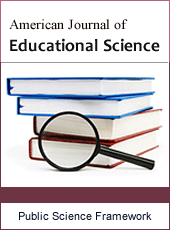American Journal of Educational Science
Articles Information
American Journal of Educational Science, Vol.4, No.3, Sep. 2018, Pub. Date: Aug. 10, 2018
Cultivating a New Learning Community to Prepare Graduate Students in Cardiovascular Epidemiology: The Jackson Heart Study
Pages: 57-62 Views: 2085 Downloads: 579
[01]
Brenda Campbell Jenkins, School of Public Health, Jackson Heart Study, Jackson State University, Jackson, USA.
[02]
Clifton Addison, School of Public Health, Jackson Heart Study, Jackson State University, Jackson, USA.
[03]
Marinelle Payton, School of Public Health, Jackson Heart Study, Jackson State University, Jackson, USA.
Objective: To describe a learning community (LC) used in the Jackson Heart Study (JHS) to train graduate students in cardiovascular epidemiology. Methods: In 2013, the JHS Graduate Training and Education (GTEC) was implemented at Jackson State University with responsibilities to develop a training program to provide opportunities for scholars to acquire professional expertise in public health and biomedical research. Results: GTEC developed a LC environment where graduate students can be exposed to academic training and expert mentoring to prepare them for a future in CVD research. Conclusions: This type of training opportunity is important for Mississippi, a state with one of the highest prevalence of CVD. To decrease morbidity and mortality by increasing the availability of well-trained public health and biomedical professionals, we concluded that well-organized learning communities can substantially increase competency, success, and overall professional proficiency.
Graduate Training, Jackson Heart Study, Cardiovascular Epidemiology, Learning Community
[01]
Campbell Jenkins BW, Addison C, Wilson G, Young L, Fields R, Woodberry C, Payton M. Implementing a graduate certificate program in cardiovascular epidemiology: The Jackson Heart Study. Int J Environ Res Public Health. 2015; 13 (1): ijerph13010026. doi: 10.3390/ijerph13010026.
[02]
Blankenstein AM, Houston PD, Cole RW. Sustaining professional learning communities. Thousand Oaks, CA: Corwin Press, 2010.
[03]
Kato MT. Community Resonance: Indigenous Epistemology and the Learning Community Program at the University of Hawaiʻi, West Oʻahu. Learning Communities Research and Practice 2018; 6 (1): Article 7. Retrieved on 6-27-2018: https://washingtoncenter.evergreen.edu/lcrpjournal/vol6/iss1/7
[04]
Marshall KS, Cabrera JF, Weaver KF. Constructing a Complex Learning Community Index – Operationalizing the Concept of a Learning Community into a Measurable Construct. Learning Communities Research and Practice 2018; 6 (1): Article 3. Retrieved on 6-21-2018 at: https://washingtoncenter.evergreen.edu/lcrpjournal/vol6/iss1/3
[05]
Ross DD, Stafford L, Church-Pupke P, Bondy E. Practicing collaboration: What we learn from a cohort that functions well. Teacher Education and Special Education 2006; 29 (1): 32-43.
[06]
Virtue E, Wells G, MacKusick C, Murphy-Nugen A, Rose A, Snyder MM. The Immortal Life of Henrietta Lacks: Using a Common Read to Transform a Learning Community. Learning Communities Research and Practice 2018; 6 (1): Article 4. Retrieved on 6-23-218 at: https://washingtoncenter.evergreen.edu/lcrpjournal/vol6/iss1/4
[07]
Sai X, Siraj S. Professional Learning Community in Education: Literature Review. The Online Journal of Quality in Higher Education 2015; 2 (2): 64-78.
[08]
Ratts RF, Pate JL, Archibald JG, Andrews SP, Ballard CC, Lowney KS. The Influence of Professional Learning Communities on Student Achievement in Elementary Schools. Journal of Education & Social Policy 2015; 2 (4): 51-61.
[09]
Higgins K. An Investigation of Professional Learning Communities in North Carolina School Systems. Journal of Research Initiatives 2016; 2 (1): Article 9: 1-21.
[10]
Pain, M. and Sidle, J (2015) Professional Learning Communities: Linking CPD to daily practice Accessed 6-25-2018 at: http://kyrateachingschool.com/professional-learning-communities-linking-cpd-to-daily-practice-michael-pain- james-siddle/
[11]
Mindich D, Lieberman A. Building a learning community: A tale of two schools. Stanford, CA. Stanford Center for Opportunity Policy in Education 2012.
[12]
Browne T, Keefe RH, Ruth BJ, Cox H, Maramaldi P, Rishel C, Rountree M. Advancing Social Work Education for Health Impact. American Journal of Public Health 2017; 107 (S3): S229-S235. DOI: 10.2105/AJPH.2017.304054. PMID: 29236540.
[13]
Harkavy I. “Engaging Urban Universities as Anchor Institutions for Health Equity”, American Journal of Public Health 2016; 106 (12): 2155-2157. DOI: 10.2105/AJPH.2016.303475. PMID: 27831784.
[14]
Johnson M, Sprowles A, Overeem K, Rich A. (2017). A Place-based Learning Community: Klamath Connection at Humboldt State University. Learning Communities Research and Practice 2017; 5 (2): Article 4. Retrieved on 6-23-2018 at: https://washingtoncenter.evergreen.edu/lcrpjournal/vol5/iss2/4
[15]
Van Grieken K, Meredith C, Packer, Kyndt E. Teacher communities as a context for professional development: A systematic review. Teaching and Teacher Education 2017; 61: 47-59.
[16]
Henning JE. Teacher leaders at work: Analyzing standardized achievement data to improve instruction. Education 2006; 126: 729-737.
[17]
Lebedina-Manzoni M. To what students attribute their academic success and unsuccess. Education. 2004 124: 699-708.
[18]
Mandzuk D, Seifert K. Student cohorts in teacher education: Support groups or intellectual communities? Teachers College Record 2006; 108 (7): 1296-1320.
[19]
Song KO, Choi J. Structural analysis of factors that influence professional learning communities in Korean elementary schools. International Electronic Journal of elementary Education 2017; 10 (1): 1-9. ISSN: 1307-9298. DOI: 10.26822/iejee.2017131882.
[20]
Osmond-Johnson P. Leading Professional Learning to Develop Professional Capital: The Saskatchewan Professional Development Unit’s Facilitator Community. International Journal of Teacher Leadership 2017; 8 (1): 26-42 ISSN: 1934-9726.
[21]
Vanblaere B, Devos G. The Role of Departmental Leadership for Professional Learning Communities. Educational Administration Quarterly 2018; 54 (1): 85-114.
[22]
Machado VMP, Machado JLM, Pereira dos Santos SR, Porfírio GJM. Aspects of the Inter Professional Learning Process of Medical Students Involved in a Family Health Unit. Scientific Research 2017; 8 (14): 2210-2221.
[23]
Kanter RM. Commitment and community: Communes and utopias in sociological perspective. Cambridge, MA: Harvard University Press 1972.
[24]
The Sullivan Commission. Missing persons: Minorities in the health professions. W. K. Kellog Foundation, 2004.
[25]
Andrade MS. Learning communities: Examining positive outcomes. Journal of College Student Retention: Research, Theory, and Practice. 2007; 9 (1): 1-20.

ISSN Print: 2381-7127
ISSN Online: 2381-7135
Current Issue:
Vol. 6, Issue 2, June Submit a Manuscript Join Editorial Board Join Reviewer Team
ISSN Online: 2381-7135
Current Issue:
Vol. 6, Issue 2, June Submit a Manuscript Join Editorial Board Join Reviewer Team
| About This Journal |
| All Issues |
| Open Access |
| Indexing |
| Payment Information |
| Author Guidelines |
| Review Process |
| Publication Ethics |
| Editorial Board |
| Peer Reviewers |


